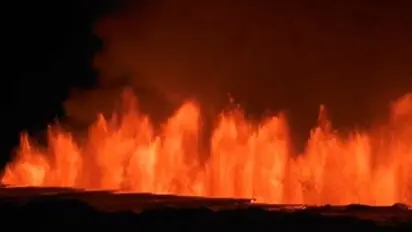Viral Video: Volcano erupts in southwest Iceland, 6th outbreak in Reykjanes peninsula since 2021 (WATCH)

Synopsis
A volcano erupted on Thursday in southwest Iceland for the second time this year, making it the sixth outbreak on the Reykjanes peninsula since 2021.
A volcano erupted on Thursday in southwest Iceland, marking the second eruption of the year in the region, as reported by public broadcaster RUV and various local media outlets. This event adds to the six outbreaks that have occurred on the Reykjanes peninsula since 2021, underscoring the region's geological volatility. Videos on X, formerly Twitter, vividly captured the scene: bright-orange molten rock spewing from fissures in the ground, illustrating the raw power of nature at work.
The previous eruption, which commenced on January 14th, lasted approximately two days. During this time, lava flows advanced towards the outskirts of the Grindavik fishing town. The town, home to nearly 4,000 inhabitants, faced evacuation measures as the encroaching lava threatened residential areas. Tragically, some houses were engulfed in flames, highlighting the destructive force unleashed by the volcanic activity.
The Reykjanes peninsula, renowned for its rugged landscapes and geothermal wonders, has been experiencing heightened volcanic activity in recent years. The frequency of eruptions underscores the dynamic nature of Iceland's geological environment, where the forces shaping the land are ever-present and unpredictable.
Local authorities and scientists continue to monitor the situation closely, assessing the impact of the eruption on surrounding communities and infrastructure. While volcanic activity contributes to the island's unique identity and natural beauty, it also poses significant challenges for residents and authorities tasked with managing its consequences.
Check the Breaking News Today and Latest News from across India and around the world. Stay updated with the latest World News and global developments from politics to economy and current affairs. Get in-depth coverage of China News, Europe News, Pakistan News, and South Asia News, along with top headlines from the UK and US. Follow expert analysis, international trends, and breaking updates from around the globe. Download the Asianet News Official App from the Android Play Store and iPhone App Store for accurate and timely news updates anytime, anywhere.